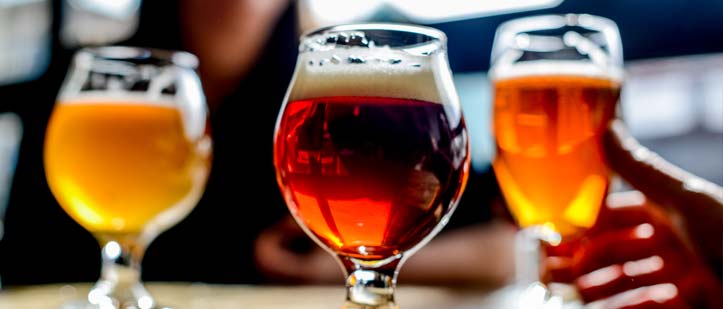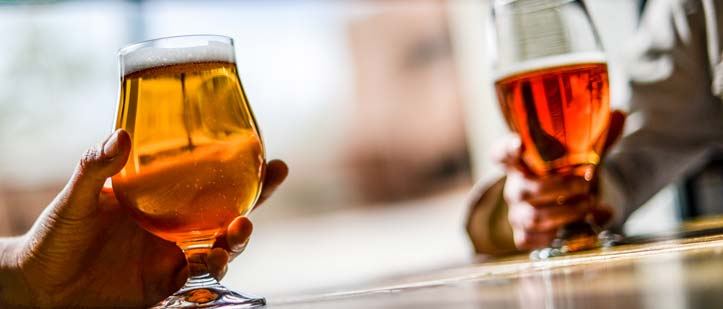There’s something special about going out to eat. It’s an experience, a moment, a memory. We all spend time researching restaurants, reading reviews, looking at menus to find the best establishments. And sometimes you have those lucky moments when you just wander into someplace truly great.
Walking in the front door, all your senses go on high alert. Sights, sounds, smells — everything is on point tonight. You can feel it: The energy that says you should be here tonight, maybe even every night. This restaurant is on its game. There’s something to learn here.
You are greeted warmly, as if a guest at someone’s home. You take in the wood beam ceilings and rich, warm lighting as you’re ushered past the bustling bar, then you pass an open kitchen full of chefs in choreographed dance. As you’re seated, you’re presented with tonight’s menu, plus three —three? — yes, three beverage lists: cocktails, wine … and craft beer.
Cheers to Great Beer Lists
Let me be the first to say “thank you” to all the restaurateurs who give craft beer the same respect as wine and cocktails. To those of you who offer craft beer pairings right there on the menu, next to suggestions for craft cocktails and wine, cheers! You are leading the way toward creating the ultimate dining experience.
To those of you thinking about adding a craft beer program, may this be the year you stop thinking and start doing. And to all the hungry, thirsty patrons out there, may the next time you eat out feature mouthwatering pairings that show your palate what craft beer can do.
I’m often asked how a restaurant goes about creating a craft beer list. Typically the folks asking fall into two camps. On one side, there are the establishments that have already started to grow their lists, but are struggling to decide what to offer. They’ve usually done some research into how the popularity of craft beer and great food has grown, or are responding to the desires of their guests. On the other side, there are establishments that might be curious about craft beer, but have not yet committed to growing their lists; they may not even have realized the benefits a good beer list can provide.
 So how does a restaurant in the latter category become convinced that it’s worth offering a better lineup of craft beers? First and foremost, it has to see that craft beer matches up with the vision. The goal of every chef and restaurant is to tell a story through food, drink and atmosphere in order to give guests an experience and a memory that they will seek to repeat. If a guest desires something, and the restaurant can provide it at the same level as everything else it does, then there is not a single successful operation out there that will not try its hardest to fulfill that desire.
So how does a restaurant in the latter category become convinced that it’s worth offering a better lineup of craft beers? First and foremost, it has to see that craft beer matches up with the vision. The goal of every chef and restaurant is to tell a story through food, drink and atmosphere in order to give guests an experience and a memory that they will seek to repeat. If a guest desires something, and the restaurant can provide it at the same level as everything else it does, then there is not a single successful operation out there that will not try its hardest to fulfill that desire.
The catch, however, is “at the same level.” No chef or restaurant will serve something that is outside their vision, their concept, their story — nor should they. So it may take some convincing to help them see how craft beer fits in. Luckily, beer is such a versatile beverage that it really can fit in anywhere.
Focus on Styles, Not Brands
To answer the question of how to build a beer list, I started by thinking about how I order drinks myself when I go out to eat. I don’t ever look for a specific brand of anything, be it spirit, wine or beer. Instead, I think of the style of beverage I want to have and how it will complement my meal, and then look for an option that meets the flavor profile I’m going for. And that’s the key to growing a craft beer list: give your guests plenty of options.
 Starting your list with specific brands or specific beers is limiting. From a culinary perspective, brand doesn’t matter — all that matters is how a beer will help to create a particular experience on your guest’s palate. So a more powerful approach is to start with a strong base list that includes a number of different styles (you can always add a favorite or popular brand later on).
Starting your list with specific brands or specific beers is limiting. From a culinary perspective, brand doesn’t matter — all that matters is how a beer will help to create a particular experience on your guest’s palate. So a more powerful approach is to start with a strong base list that includes a number of different styles (you can always add a favorite or popular brand later on).
I suggest that restaurants beginning to serve craft beer should start by offering the following eight styles. These will form the foundation of a very solid craft beer list that can grow alongside the establishment and its customers.
Foundational Beer Styles
- American amber ale
- American brown ale
- American India pale ale
- American stout or English-style brown porter
- American pale ale
- German-style Pilsner or German-style kolsch
- Belgian-style saison or farmhouse ale
- American wheat or Belgian-style wit
With these eight styles, any restaurant with any menu can be sure of two things: first, that no matter what kind of beer a guest is in the mood for, there will be something on the list they’re excited to see; and second, that the restaurant can begin to pair craft beer on the same level as its other beverage programs. From there, the craft beer list can grow to continue to meet the desires of the restaurant and the guests coming through the door every night.
Deciding exactly which craft beers to bring into a restaurant can be tricky. With so many craft breweries out there producing great beer, sorting through the options can be intimidating for many restaurants. But knowing that their guests want a craft beer experience, many establishments are happy to take on the challenge of expanding their craft beer lists.
So the next time you go out to eat, may everything line up just right to give you an amazing experience — and may you have a local craft beer resting in the glass next to your plate. If you don’t, encourage the restaurant to beef up its craft beer list before your next visit. Cheers!
CraftBeer.com is fully dedicated to small and independent U.S. breweries. We are published by the Brewers Association, the not-for-profit trade group dedicated to promoting and protecting America’s small and independent craft brewers. Stories and opinions shared on CraftBeer.com do not imply endorsement by or positions taken by the Brewers Association or its members.


Share Post